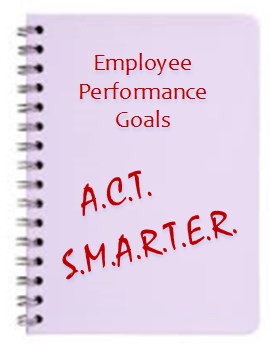ACT SMARTER Goals
Setting goals using the SMART criteria has been around since the early 1980’s. The SMART goal model is a great way to ensure the basic elements of the goal are included as you created them. However, when it comes to setting employee performance goals there are additional criteria that should be included.
To help ensure all the key criterion for employee goals were included, The Peak Performance Center crafted “ACT SMARTER” which is an acronym for the following:
Agreed
Controllable
Tied
Specific
Measurable
Achievable
Relevant
Time bound
Ethical
Rewarding
ACT SMARTER Overview
Agreed – The employee is involved in the goal setting process and collaborates to create them
Controllable – The employee’s own efforts mostly determine whether the goal will be achieved
Tied – The goal is aligned with the organization’s strategic objectives
Specific – The goal is detailed enough to clearly state the exact level of performance expected
Measurable – The goal has either a quantitative or qualitative assessment to gauge success
Achievable – The goal challenges and stretches the employee’s abilities, but realistically is able to be attained
Relevant – The goal focuses on something that is core to the employee’s tasks and responsibilities
Time-bound – The goal has a target completion date
Ethical – The goal is based on ethical and moral standards
Rewarding – The goal motivates and gives the employee a sense of satisfaction once achieved
About ACT SMARTER
Agreed
The first step to effective goals setting is to get the employees involved. Having employees actively involved in identifying and creating his or her own goals increases “buy-in” and ownership. Typically, there is a higher chance of achieving the goal when the employee feels there is collaboration and agreement in setting it, and not having the goal forced upon them. They feel they are part of the decision making process and their opinion is valued. Often resentment and animosity develop if they feel they are simply being told what to do, when to do it, and how to do it.
Additionally, active participation in the goals setting process allows the employee to better understand how their individual goals fit with the mission and objectives of the organization. Explaining the organizations goals and asking the employee how they think they can contribute to the accomplishment of those goals helps them understand what their role is in the bigger picture.
Controllable
Employee’s goals should be mostly under his or her control. That is, the employee’s efforts should determine whether the goal is achieve or not. It should not be controlled by other external forces such as other employees, other departments, customers, or the business environment.
Although most goals involve interaction or collaboration with others, a large percentage of control should be with the employee. For example, instead of a goal of “finishing in the top five in sales for the month”, have a goal of “selling 15 items.” This way the employee has more control of how many he or she sells than they do on being in the top five. If several other people have a strong sales month, the top five finish may not happen for the employee even if they sold 20 items.
Tied
Individual employee goals should be tied to the strategic goals and objectives of the organization. Tying employee goals to the organization’s goals helps ensure everyone is working towards the same goal.
Also, aligning the goals helps the employees understand how their individual tasks and responsibilities contribute to organizational growth and success. It gives the employee the feeling of contributing to something bigger than just their daily job responsibilities.
Specific
Specific means the goal should be detailed enough to clearly describe what is to be accomplish. Everyone involved should know exactly what needs to be done. It should not be overly broad or ambiguous, because that could lead to confusion on what is to be achieved.
Measurable
It is important to know if the goal has been successfully reached. This cannot be determined unless it can be measured. Therefore, establish concrete criteria for measuring progress toward the attainment of each goal. There should be a numeric or descriptive measure that is quantifiable.
Also, if it has a quantifiable measurement, it can be tracked for progress. Seeing the progress towards the goal can help the employee stay motivated and focused on the continued effort required to reach the goal.
Achievable
Achievable means it is not just a lofty target, but something within the employee’s reach. The goals should be ambitious, but also realistic. The best goals require the employee to stretch his or her abilities, but not so far that the goal cannot be attained. If the goal is set too high, it may seem unattainable to the employee, and they may lose motivation early on.
Also, the employee must possess the appropriate knowledge, skills, and abilities needed to achieve the goal. If not, there should be a plan to obtain the knowledge or develop the necessary skill.
Relevant
Relevant means it is core to the employee’s tasks and responsibilities. Create goals that are directly related to the employee’s job duties. The employee should be able to accomplish the goals by performing his or her daily tasks. They should not have to take time away from their core responsibilities to make progress towards the goal. For example, the goal should not be “attend four seminars this year to improve your communication skills.” Even though the seminars may help the employee do his or her job better, attending the seminars would direct their focus away from their core responsibilities.
Time-bound
Time-bound means the goal is not open-ended. There should be a timeframe for completion. All of the employee goals should have a target date for completion that can be found on a calendar.
A commitment to a deadline helps focus the employee’s efforts on completion of the goal on or before the set time.
Ethical
Employee goals should be ethical and aligned with the organization’s values.
If a goal is created to take advantage of other people or a situation, it may not be considered unethical, and most people resist acting unethically. Therefore, create goals that are comfortably within the employee’s moral compass.
Also, goals can sometime cause ethical dilemmas, especially if they are set too high and are time-bound. Employee may feel they need to cut corners, lie, or be deceitful just to accomplish the goal.
Rewarding
Goals need to be rewarding for the individual. Rewarding goals will challenge and motivate the employee. Highly-motivated employees have a willingness to get the job done efficiently and effectively. This willingness results in benefits for the organization including higher productivity, increased revenue, and cost savings.


